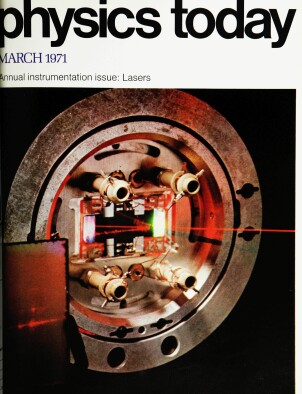Junction lasers
DOI: 10.1063/1.3022625
Junction lasers are devices in which laser action is produced by a high, nonequilibrium concentration of electrons and holes within the same small region of a semiconductor. Why do we want junction lasers? They are interesting not only from the viewpoint of the physics involved; their properties suit them for industrial application as well. The advantages include:
▸ Smallness: Dimensions of the active region are typically one to two microns, with the largest dimension usually no more than a fraction of a millimeter.
▸ Mechanical stability: The mirrors are an integral part of the laser structure, and are usually formed by cleaving the crystal.
▸ High efficiency: Pulsed junction lasers have operated at as much as 40% external quantum efficiency.
▸ Reasonable power: Continuous output of 40 mW has been obtained at room temperature, with much higher powers at low temperatures. The record peakpower output in a 100‐nanosec pulse is about 100 watts.
▸ Versatility: Junction lasers are conveniently pumped with direct current, and their output can be amplitude, frequency or pulse‐position modulated into the GHz range. They can lase at wavelengths from 20 to 0.75 microns with the proper choice of semiconductor alloy, and can operate in a single mode. Within the last year, junction lasers have been operated continuously at room temperature.
References
1. G. Burns, M. I. Nathan, Proc. IEEE, 52, 770 (1964);
M. I. Nathan, Proc. IEEE, 54, 1276 (1966);
C. H. Gooch, Gallium Arsenide Lasers, Interscience, London (1969);
S. M. Sze. Physics of Semiconductor Devices, Interscience, New York (1969), page 687.2. I. Hayashi, M. B. Panish, P. W. Foy, S. Sumski, Appl. Phys. Lett. 17, 109 (1970).https://doi.org/APPLAB
3. M. G. A. Bernard, G. Duraffourg, Physica Status Solid 1, 699 (1961).
4. A. K. Jonscher, M. H. Boyle, Gallium Arsenide: 1966 Symposium Proceedings, IPPS, London (1967).
5. D. K. Wilson, in Radiative Recombination in Semiconductors, Academic, New York (1964), page 171.
6. W. E. Ahearn, J. W. Crowe, IEEE J. Quantum Electronics QE‐2, 597 (1966).
7. M. B. Panish, S. Sumski, I. Hayashi, Metallurgical Trans, (to be published).
8. T. L. Paoli, J. E. Ripper, Phys. Rev. Lett. 22, 1085 (1969).
9. T. L. Paoli, J. E. Ripper, Appl. Phys. Lett. 15, 105 (1969).https://doi.org/APPLAB
10. G. E. Fenner, Solid‐State Electronics 10, 753 (1967).https://doi.org/SSELA5
11. J. E. Ripper, IEEE J. Quantum Electronics QE‐5, 391 (1969).
12. J. E. Ripper, J. C. Dyment, Appl. Phys. Lett. 12, 365 (1968).https://doi.org/APPLAB
13. J. E. Ripper, T. L. Paoli, J. C. Dyment, IEEE J. Quantum Electronics QE‐6, 300 (1970).
14. T. L. Paoli, J. E. Ripper, Proc. IEEE 58, 1457 (1970).https://doi.org/IEEPAD
15. G. E. Fenner, Appl. Phys. Lett. 5, 198 (1964).https://doi.org/APPLAB
16. G. W. Pratt, J. E. Ripper, J. Appl. Phys. 36, 1525 (1965).https://doi.org/JAPIAU
17. J. M. Besson, J. F. Butler, A. R. Calawa, W. Paul, R. H. Rediker, Appl. Phys. Lett. 7, 206 (1965).https://doi.org/APPLAB
18. G. W. Pratt Jr, P. G. McMullin, in Proceedings of the Tenth International Conf. on the Physics of Semiconductors, Cambridge, Mass. (1970).
19. J. F. Butler, T. C. Harman, Appl. Phys. Lett. 12, 347 (1968).https://doi.org/APPLAB
20. E. D. Hinkley, T. C. Harman, C. Freed, Appl. Phys. Lett. 13, 49 (1968).
21. E. D. Hinkley, C. Freed, Phys. Rev. Lett. 23, 277 (1969).
22. J. O. Dimmock, I. Melngailis, A. J. Strauss, Phys. Rev. Lett. 16, 1193 (1966).https://doi.org/PRLTAO
23. J. B. ConklinJr, L. E. Johnson, G. W. PrattJr, Phys. Rev. 137A, 1282 (1965).https://doi.org/PHRVAO
24. T. C. Harman, A. R. Calawa, I. Melngailis, J. O. Dimmock, Appl. Phys. Lett. 14, 333 (1969).https://doi.org/APPLAB
25. J. F. Butler, Solid State Commun. 7, 909 (1969).https://doi.org/SSCOA4
26. J. C. Dyment, Appl. Phys. Lett. 10, 84 (1967).https://doi.org/APPLAB
27. T. L. Paoli, J. E. Ripper, T. H. Zachos, IEEE J. Quantum Electronics QE‐5, 271 (1969).
28. I. Hayashi, M. B. Panish, F. K. Reinhart, J. Appl. Phys. (to be published).
29. J. E. Ripper, J. C. Dyment, L. A. D’Asaro, T. L. Paoli, Appl. Phys. Lett. 18, 155 (1971).https://doi.org/APPLAB
30. J. C.3 Dyment, J. E. Ripper, IEEE J. Quantum Electronics QE‐4, 155 (1968).
More about the Authors
L. A. D'Asaro. Bell Telephone Laboratories, Murray Hill.
José E. Ripper. Bell Telephone Laboratories, Murray Hill.
